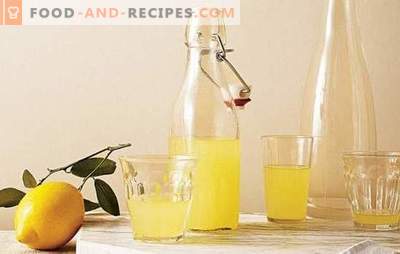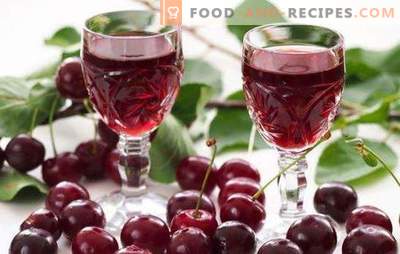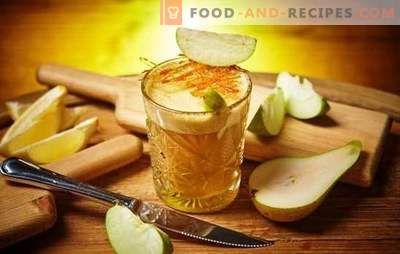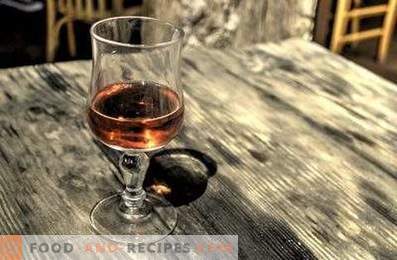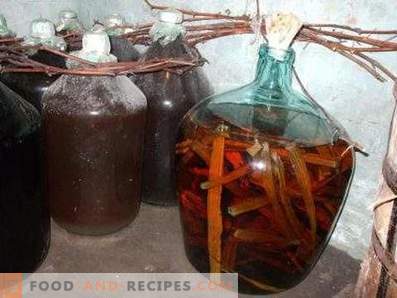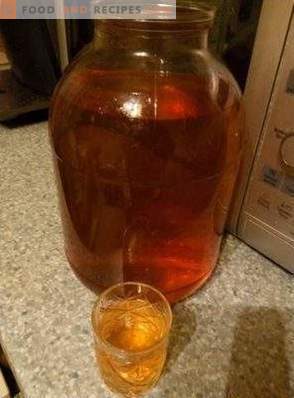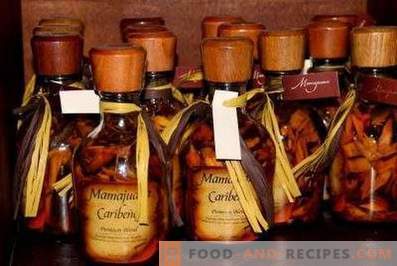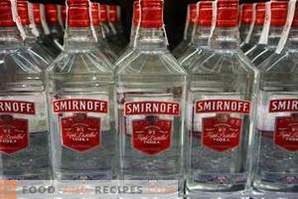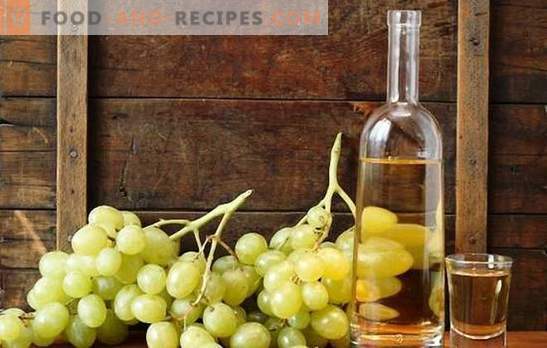
Making homemade tinctures many centuries ago laid the foundation for alcoholic beverage production, but the modern industrial assortment of tinctures still did not diminish the ardor of homemade tincturers. Therefore, the recipes of this alcoholic drink are constantly updated and replenished.
Homemade tincture is often a technology of random coincidences, a constant search and experiment, the results of which are sometimes difficult to predict. This is exactly how gin, bittner, vermouth, balsam, “Erofeich”, liqueur appeared. These alcoholic drinks have similar technologies with the preparation of tinctures.
Grapes are a special fruit, and grape wine, as a healing drink, is repeatedly mentioned even in the Bible. But the manufacture of homemade wine is a long, costly and very time consuming process, and, unfortunately, it is, for objective reasons, not available to everyone. Buy 2-3 kilograms of fresh berries and a bottle of vodka to prepare a healing elixir - much easier. But some basic knowledge is necessary for this.
Tincture of grapes on vodka - the basic technological principles
Tincture and brandy, balsam and liqueur, gin and bittner, vermouth and brandy - alcoholic beverages, which are made by the method of extraction. Each of these alcoholic beverages has its own unique composition. Balsam and Bittner - multicomponent herbal infusions. The main "highlight" of gin is juniper. Vermouth has a tart and slightly bitter wormwood bouquet. Tincture of grapes on vodka belongs to the category of fruit tinctures, if we talk about industrial classification.
Classification of tinctures by composition
All tinctures are classified not only by the composition of the raw materials (fruits, herbs, roots, spices), but also by the content of sugar and alcohol. This method of division is conditional, it is - only an attempt to somehow deal with the range. In practice, especially in the manufacture of homemade alcoholic beverages, these rules consist of continuous exceptions. By the amount of sugar tinctures are bitter, semi-sweet and sweet. The strength of bitter tinctures, as a rule, has the highest alcohol content - 30-60%, and drinks with an alcohol content of more than 50% are classified as balsam-type alcohol. In bitter tinctures, the sugar content does not exceed 3%.
Semisweet tinctures are divided into two types: strong and weak degrees. Semi-sweet tinctures contain 30-40% alcohol, 4-10% sugar.
Next category - low-grade semi-sweet tinctures, with alcohol content from 20% to 30%. In these drinks, the sugar content is also 4-10%. For sweet infusions, the norm of alcohol is 16-25%, and the amount of sugar is 8-30%.
Sweet tinctures with a sugar content of 30% are close in composition to another type of liquor products - liqueurs, but have a lower percentage of alcohol.
Industrial technologies for making tincture of grapes on vodka will differ from homemade recipes by strict regulations, requirements for strict adherence to the recipe. At home, each master can relax and allow himself to mix fruit notes with the smell of field herbs, oriental spices, or the scent of other fruits.
As basic principles for making tinctures from industrial methods, it is worthwhile to adopt only some technological methods.
Extraction Methods
Extraction - the process allows to obtain the extract from vegetable raw materials using extractants (solvents):
- water (for infusions: herbal tea, coffee, compote - water extraction);
- alcoholized liquids of various strengths (vodka, moonshine, alcohol, cognac, brandy);
- vegetable oils.
Relatively quickly, without the use of thermal and mechanical effects, you can get alcoholic extract. The saturation of the tincture will be the higher, the stronger the extractant. For water infusions, as is known, it is necessary to heat the raw material. The heating method is also applicable to alcohol solvents, but here we must take into account that when vodka or other liquids containing alcohol are heated, the alcohol volatilizes. In this regard, for the preparation of tincture of grapes on vodka, the method of heating is applied only under the condition that the heated container with the extract is tightly closed. In addition, it is impossible to allow the liquid to reach the boiling point, so the heating is performed in stages, in several stages. The mechanical method of extraction consists in grinding the raw material: smaller particles of fruits and other components “release” substances into the liquid faster. It is also very effective another mechanical method. In industrial conditions, where there are necessary conditions, raw materials and alcohol are placed in special rotating tanks with heating. Rotation also speeds up the process.
At home, for such techniques, you can apply heated cans with tincture in a water bath, in a slow cooker (heated in a closed container). It is more difficult to choose household appliances for the formation of centrifugal force, since it is not recommended to open the container with the future tincture during the infusion process. There is only one possible way - shaking a closed can manually.
Extract and store tincture
Using the methods of accelerating the extraction of fruit tincture will be ready in about a week, if its composition does not include more solid ingredients. Infusion time can last up to two months. After that, the tincture is filtered, if necessary - several times, seeking transparency.
Please note, that insisting under the influence of sunlight gives the tincture a lighter color, and when the temperature in the sun rises, the tincture acquires, in addition to the reddish hue, also smoked taste. Aging in a dark room gives a natural and rich color to the drink. What conditions to choose for tincture depends, of course, on the individual taste.
Ideally, the most expensive and high-quality tinctures are kept in oak barrels, but at home this expensive container can be completely replaced with a glass container, wrapping it in thick paper or foil so that you can open it at the right moment to watch the process. The glass does not dissolve with alcohol, and in order to improve the quality of the tincture, except for all the necessary ingredients, add oak bark (for brandy, brandy or rum) or juniper berries (for gin) to the jar - this little trick will give homemade grape vodka tincture special charm.
Recipe 1. Vodka on grapes - tincture, bitter brandy
Composition:
- Oak bark 50 g
- Vanilla 15 g
- Cloves 10 g
- Muscat 20 g
- Sugar 100 g
- Grapes, white 1 kg
- Coffee, ground 70 g
- Vodka (40%) 3 l
Preparation:
Ground spices and grapes (preferably with a bone) put in a jar of suitable size. Grapes are better to pre-knead or chop with a blender. Pour the vodka and close the dishes with a lid. Shake the contents well and repeat this procedure daily. You can periodically warm up the tincture in a water bath, without opening the lid, up to 40 ° C, or simply wrap it in an opaque material and keep it warm for at least two months. After passing through a tight filter, pour into bottles, cork tightly and store at room temperature.
Tincture can be stored for several years until you drink. For the collection, leave the bottle and draw a “star” on it every year.
Recipe 2. Semisweet tincture of grapes on vodka, slightly wormwood
Composition:
- Vodka (40%) 2.0 l
- White, nutmeg grapes 2.5 kg
- Sugar syrup 800 g
Herbal Composition:
- Yarrow - 8%,
- Cinnamon - 7%,
- Wormwood extract (lemon wormwood) 5%
- Clove 2%
- Tansy 8%
- Elderberry, black (flowers) 6%,
- Nutmeg, ground 5%,
- Elecample high 2%
- Juniper berry 1%
- Donnik, yellow 8%
- Immortelle (flowers) 5%
- Oregano 10%
- Pygil, pharmacy 4%
- Hypericum 5%
- Vanilla extract 10%
- Ginger 3%
- Air (root) 6%
- Coriander 7%
- Melissa, lemon 15%
- Iris root 10%
- Peppermint 5%
- Cardamom 8%
- Chamomile, pharmacy 10%
Preparation:
Herbal composition is designed in such a way as to emphasize the necessary shades of taste and aroma, give them strength, fix them. The percentage indicated is the total mass of the liquid.
First you need to grind grapes, combine it with sugar and vodka. Hold the container with the future tincture for 7 weeks at normal room temperature, then filter. The grape mass can be squeezed, but not filtered. Further, the composition of herbs, flowers, roots and spices is placed in the drink. Slab centigrade tincture must be tightly sealed and maintained at a temperature of 22-25 ° C for 3-4 months. After the finished drink is thoroughly filtered; If necessary, filtering and settling alternate several times in order to achieve purity and transparency. After bottling, the corked bottles are stored at 18-20 ° C.
Recipe 3. Vodka on grapes and mountain ash
Composition:
- Rowan 0.5 kg
- Grapes, nutmeg 500 g
- Vodka, purified (50%) 2.0 L
- Sugar syrup 200 g
Preparation:
All berries are sorted, washed and dried in the oven at 40 ° C to remove the juice (dry up). Then the raw materials need to be crushed and put in a glass bottle. Pour syrup and vodka. Stir and close the lid. Put the container in a dark and warm place for 15-20 days. You can periodically shake the bottle without opening it. Drain the liquid in a clean dish. Press through the gauze filter thick in a separate container. Let stand, and then combine with the total mass.
Recipe 4. Bitter tincture of grapes on vodka, with juniper and citrus
Composition:
- Grape juice 750 ml
- Vodka, wheat (50%) 3.0 l
- Citrus zest (lemon, orange) 150 g
- Cardamom 50 g
- Juniper (berries or young shoots) 30 g
- Cinnamon 5 g
- Anise 2 g
Preparation:
All spices insist separately. To do this, split the wheat vodka in proportion and pour it into jars. In each of the cans, place the cooked ingredients and draw them for at least two weeks. Grapes can be crushed into a mush and also insist on vodka separately, and then filtered and together with the juice combined with the resulting tinctures. The advantage of such a separate method of preparation of the tincture is that you can create the necessary bouquet of ready-made tinctures, adjusting their quantity when added to the total mass. After connecting the tinctures, you must give them time to form a common bouquet. Withstand the tincture more, not less than a week.
Recipe 5. Vodka on grapes with almond aroma - sweet tincture
Composition:
- Raisins, red 500 g
- Dried apricots 700 g
- Bitter almonds (unpeeled) 100 g
- Sugar syrup 600 g
- Vanilla (extract) 10 ml
- Vodka 2.5 L
Preparation:
Grind all the ingredients and put in the bottle. Pour syrup and vodka, mix. Close the lid tightly and store the container in the kitchen cupboard for 2-3 months. After filter through the gauze, folded in several layers, squeeze the thick. Let stand for several days to make sure the drink is transparent. If necessary, filter again.
Recipe 6. Ginger-anise tincture of grapes on vodka, semi-sweet
Composition:
- Grape juice (clarified) 1.0 l
- Honey 200 g
- Ginger (fresh root) 100 g
- Vodka 3.0 L
- Anis 20 g
Preparation:
In the vodka, put the peeled and chopped ginger root, 3-4 "star" anise (star anise). Insist 10-15 days, strain. In the finished tincture pour the cooked grape juice with honey. To do this, juice with honey before boil and remove the foam. Cool and let stand so that it acquires transparency.
After combining the tincture with juice, the drink should brew for another 2-3 days.
Vodka on grapes - useful tips and tricks
- Do not forget about the beneficial properties of grape seed. The tincture made from them is the elixir of youth and longevity.
- The quality of any tincture depends on the alcoholized liquid. If you use home-brew, instead of vodka, to make tinctures, then make sure that it is well cleaned first. Even the slightest smell of impurities will not give the desired result, and fusel oils can turn the healing properties of tinctures into poison. To avoid this, clean the vodka or moonshine before you start preparing the tincture. To do this, in a container with vodka, put tablets of activated carbon and infuse them at least a day. Then filter the vodka or moonshine, and you can start preparing tinctures.
